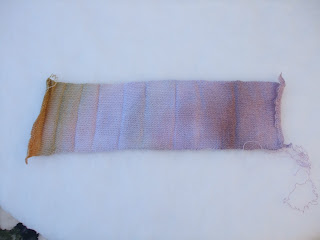The continuing perfect weather for spinning and knitting has given me the opportunity to start a project that I have been planning for a while - creating 'sushi rolls' for knitting socks, shawls or other items with unusual dye effects.
Its not an original idea - I should give credit to Jon 'easyknitter' Dunne who creates gorgeous individualy dyed yarns. Check out the easyknitter website....
I decided to have a go at making sushi rolls myself when a) friend gave me an old knitting machine and b) I aquired a large cone of very fine white yarn of unknown fibre content, for £1 in a charity shop. The third necessary element (time) was supplied courtesy of yet more snow making it impossible to go and visit my stepfather in Oban (again).
First step: getting the knitting machine to work.
My mum had a similar machine, rather more basic, in the 1970's, and I had some vague memories of how to use it.Luckily my friend had also given me the instruction manual, so once I had given the machine a fairly cursory cleaning I followed the setting up instructions (with some trepidation) and gave it a go - bingo!! It worked perfectly!!!
Next step: figure out how much yarn to knit for each sushi roll. As the rolls are usually made for knitting socks, I figured that the length of yarn in a ball of sock yarn should be the minimum to aim for - 420 m in 100g ball of Trekking.
My white yarn was much finer than sock yarn, so I based all my calculations on using it double.
As long as each sushi roll contains 130g double yarn (before dyeing) there should be more than enough to knit a pair of socks, or any other project that can be knitted from a 100g ball of a standard sock yarn.
Winding the yarn was a fairly time consuming and tedious process, but the knitting went fairly quickly. It must be good exercise for the upper arms and pecs - bye bye bingo wings!!
I knitted 4 strips to experiment with -
Imagine how long that would take to knit by hand - each one took about 20 minutes on the knitting machine!!
I also knitted a mini sushi strip as a sample = first for pressing, then for dyeing.
The stocking stitch strips had a tendency to roll in from the edges, so I had to press them so they would stay flat for painting on the dye.
The exciting bit - dyeing!
I started my dying experiments with the skein of yarn I had wound for teting the weight. After soaking it I put a stock solution of Kemtex acid dye (blue) on one end of the skein. and some powdered Omega (all in one) dye in Coral on one part and Malachite on another part. I put a little boiling water over the dye powders, and then wrapped the skein in clingfilm.
I use an old microwave for dyeing small quantities - it is very temperamental and I never stay in the room while it is on as I'm sure it leaks microwaves, but it is preferable to using the one I cook in!
I gave the skein a couple of 5-minute blasts in the microwave and then left it to sit overnight.
When I took it out the skein appeared purplish blue all over, but as I rinsed it almost all of the lue rinsed away, leaving a pink shade with occasional bluish flecks. So - the Kemtex didn't appear to have taken.
The cotton string that I had used to tie the skein had dyed dark purplish blue, with some aubergine-purple bits. Thius suggests that the white yarn is not cotton, although it looks and feels like mercerised cotton.
Second dye test - the knitted sample strip
I made up stock solutions of 9 colours of Omega dyes, then put a line of each colour in turn on to the (soaked) knitted strip, leaving a white space between each.
After mocrowaving the colours looked promising, but a lot rinsed out. Also, the mahogany seemed to have spread, muting the colours
For sushi roll 1 I used more dye, but only 4 colours: sungold, flame, moss and mahogany
Sushi roll 2 also had colours: Purple, Coral, malachite and marine blue. It also had twice as many 5-minute bursts of microwaving. Better, but still more muted colours than I would like.
For my next dyeing experiments I will try soaking the knitted strip (with and without vinegar in the water) and then applying dry dye powder...... watch this space!





No comments:
Post a Comment